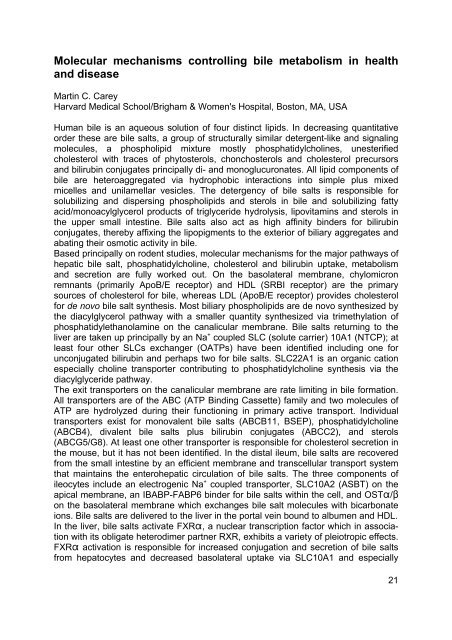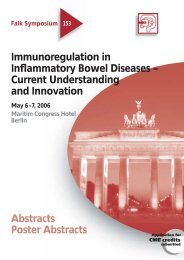Abstracts Poster Abstracts - Dr Falk
Abstracts Poster Abstracts - Dr Falk
Abstracts Poster Abstracts - Dr Falk
You also want an ePaper? Increase the reach of your titles
YUMPU automatically turns print PDFs into web optimized ePapers that Google loves.
Molecular mechanisms controlling bile metabolism in healthand diseaseMartin C. CareyHarvard Medical School/Brigham & Women's Hospital, Boston, MA, USAHuman bile is an aqueous solution of four distinct lipids. In decreasing quantitativeorder these are bile salts, a group of structurally similar detergent-like and signalingmolecules, a phospholipid mixture mostly phosphatidylcholines, unesterifiedcholesterol with traces of phytosterols, chonchosterols and cholesterol precursorsand bilirubin conjugates principally di- and monoglucuronates. All lipid components ofbile are heteroaggregated via hydrophobic interactions into simple plus mixedmicelles and unilamellar vesicles. The detergency of bile salts is responsible forsolubilizing and dispersing phospholipids and sterols in bile and solubilizing fattyacid/monoacylglycerol products of triglyceride hydrolysis, lipovitamins and sterols inthe upper small intestine. Bile salts also act as high affinity binders for bilirubinconjugates, thereby affixing the lipopigments to the exterior of biliary aggregates andabating their osmotic activity in bile.Based principally on rodent studies, molecular mechanisms for the major pathways ofhepatic bile salt, phosphatidylcholine, cholesterol and bilirubin uptake, metabolismand secretion are fully worked out. On the basolateral membrane, chylomicronremnants (primarily ApoB/E receptor) and HDL (SRBI receptor) are the primarysources of cholesterol for bile, whereas LDL (ApoB/E receptor) provides cholesterolfor de novo bile salt synthesis. Most biliary phospholipids are de novo synthesized bythe diacylglycerol pathway with a smaller quantity synthesized via trimethylation ofphosphatidylethanolamine on the canalicular membrane. Bile salts returning to theliver are taken up principally by an Na + coupled SLC (solute carrier) 10A1 (NTCP); atleast four other SLCs exchanger (OATPs) have been identified including one forunconjugated bilirubin and perhaps two for bile salts. SLC22A1 is an organic cationespecially choline transporter contributing to phosphatidylcholine synthesis via thediacylglyceride pathway.The exit transporters on the canalicular membrane are rate limiting in bile formation.All transporters are of the ABC (ATP Binding Cassette) family and two molecules ofATP are hydrolyzed during their functioning in primary active transport. Individualtransporters exist for monovalent bile salts (ABCB11, BSEP), phosphatidylcholine(ABCB4), divalent bile salts plus bilirubin conjugates (ABCC2), and sterols(ABCG5/G8). At least one other transporter is responsible for cholesterol secretion inthe mouse, but it has not been identified. In the distal ileum, bile salts are recoveredfrom the small intestine by an efficient membrane and transcellular transport systemthat maintains the enterohepatic circulation of bile salts. The three components ofileocytes include an electrogenic Na + coupled transporter, SLC10A2 (ASBT) on theapical membrane, an IBABP-FABP6 binder for bile salts within the cell, and OST"/$on the basolateral membrane which exchanges bile salt molecules with bicarbonateions. Bile salts are delivered to the liver in the portal vein bound to albumen and HDL.In the liver, bile salts activate FXR", a nuclear transcription factor which in associationwith its obligate heterodimer partner RXR, exhibits a variety of pleiotropic effects.FXR" activation is responsible for increased conjugation and secretion of bile saltsfrom hepatocytes and decreased basolateral uptake via SLC10A1 and especially21



